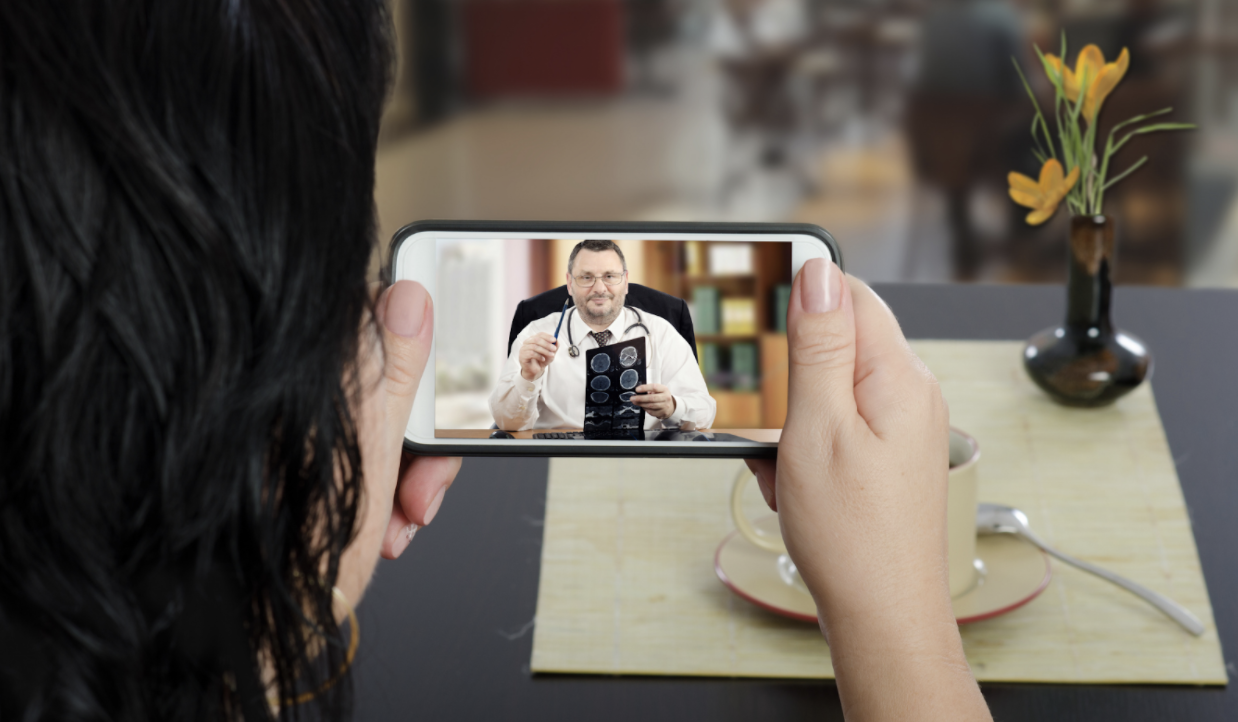Will Telemedicine Be a Mainstay for Myeloma Patients After the Pandemic?
The Patient Empowerment Network (PEN) is fostering change toward achieving equitable healthcare for all. One resource, the Myeloma TelemEDucation Empowerment Resource Center is to significantly improve multiple myeloma patients’ and caregivers’ familiarity with remote access to healthcare, and thus increase quality of care regardless of geographical location. This one-of-a-kind resource center is intended to educate the myeloma community on the practical usage of telemedicine tools, to humanize patient and provider experiences.
Here’s a summary view of the knowledge gained about telemedicine to help provide optimal care to myeloma patients and to aid in receiving optimal care no matter virus limitations, where patients live, and other factors.
Benefits and Limitations of Telemedicine Visits
There are both benefits and limitations of telemedicine visits. Some benefits of telehealth include:
- Telemedicine allows care providers the opportunity to determine when myeloma patients really need to be seen in-person.
- Standard of care and maintenance treatment are usually a good fit for using some telemedicine visits in clinical trials.
- The option to get laboratory work done closer to home is a benefit for saving travel time and from taking time off of work and also lessens patient exposure to viruses.
- Telehealth allows care providers the opportunity to meet family members of some patients who can’t make it to in-person visits and to get to know their patients on a more personal level.
- Care providers are now able to provide second opinions to patients in other parts of their state and even to some patients across the country.
Unfortunately, some limitations of telehealth include:
- Gauging toxicity and other things with new treatments are usually best done along with performing a physical exam.
- Some patients only have technology access to talk over the phone and don’t have access to use video due to their device or due to lack of Wi-Fi bandwidth.
- Physical examinations cannot be performed via telehealth visits.
- Some providers feel it’s more difficult to establish a bond with some patients and to have considerable discussions with then over telemedicine.
- Open and honest communication between patients and care providers is sometimes better served in-person.
How to Optimize a Telemedicine Visit
Just like in-person care visits, telemedicine visits are scheduled with a time limit in mind. Some things to remember about telemedicine visits are:
- Try to write down your questions for your doctor or care provider before your appointment to keep on track. Keep it next to you for easy access during your visit.
- If patients normally have a friend or loved one join or doctors have a nurse or pharmacist join for in-person visits, have them join your telemedicine visits to help take notes, to ask questions, and/or to provide answers or additional information.
- If a video conferencing tool is needed for your visit, install the tool on your laptop, tablet, or smartphone ahead of time to prevent rushing before your appointment. If possible, try to test the video conferencing tool with a friend or loved one a day or so ahead of your appointment.
- If there’s anything you don’t understand during the appointment, ask your doctor to explain it again – whether it’s medication instructions, test results, a new medical term, or anything else.
- If you feel like a treatment isn’t working well for you, ask your doctor about possible medication or dosage changes.
- Just like in-person doctor visits, your doctor or care provider may run a few minutes late. Try your best to remain flexible and to be patient.
Telemedicine and Multiple Myeloma Clinical Trials
To the surprise of some, telemedicine has taken a role in multiple myeloma clinical trials. Currently, and looking to the future, patients can expect:
- Telemedicine to continue as an option for follow-up visits along with in-person visits in clinical trials.
- Paperwork for clinical trials to be available to complete online for an easier process for joining clinical trials.
- Multiple myeloma clinical trials to provide optimal care through the use of both telemedicine and in-person visits.
- Telemedicine to provide more options for clinical trial access for those who live in remote areas.
- Multiple myeloma clinical trials for quality-of-life studies, engagement studies, educational studies, and possibly others to be available via telemedicine.
Financial Benefits of Telemedicine
Telemedicine has brought some financial benefits for multiple myeloma patients, including:
- Telemedicine saves the time and costs of traveling to appointments and can reduce or sometimes eliminate the need to take time off from work for an appointment.
- The option of connecting with your doctor via telemedicine can sometimes eliminate the need for costly urgent care visits.
- The use of telemedicine eliminates the need to find child care for patients and care partners with young children who couldn’t take them along to in-person doctor appointments.
Telemedicine Glossary
Here are some helpful telemedicine terms to know:
- HIPAA – HIPAA, or the Health Information Portability and Accountability Act, is a healthcare compliance law providing data security and privacy for the safeguarding of patient medical information. In telemedicine, provider-patient communication must take place through HIPAA-compliant secure platforms.
- Patient portal – a secure Internet sign-on that allows patients to contact their provider, review medical tests and records, access health education materials, and seek appointments. Most provider networks develop a patient portal before they move to full video appointments.
- Remote monitoring – type of ambulatory healthcare where patients use mobile medical devices to perform a routine test and send the test data to a healthcare professional in real-time.
- VPN – a VPN, or virtual private network, is a secure and private way to connect to the Internet over public wireless connections. VPNs are particularly important for those living the digital nomad lifestyle and connecting in foreign countries where networks may be more vulnerable to communication transmission interference.
Now that telemedicine tools continue to increase in use and to be refined, multiple myeloma patients can feel hopeful about improved care and treatment ahead for patients. As a step in that direction, take advantage of the resources below and continue to visit the Myeloma TelemEDucation Empowerment Resource Center for informative content about multiple myeloma and telemedicine.
Resources for Telemedicine and Multiple Myeloma
Are There Limitations of Telemedicine for Multiple Myeloma Patients?
How Will the Pandemic Impact Multiple Myeloma Trials?
Is Telemedicine Here to Stay for Multiple Myeloma Care?
What Are the Benefits of Telemedicine for Myeloma Patients?
How to Make the Most of a Virtual Visit
Telemedicine & Second Opinion Options
What Are Best Practices for Multiple Myeloma Patients Utilizing Telemedicine?
How Can Myeloma Patients Reduce Infection Risks During Medical Appointments?
Financial Resources for Patients and Families
Will Telemedicine Mitigate Financial Toxicity for Myeloma Patients?
Will Telemedicine Be a Long-Term Survival Tool for Myeloma Patients?
What Are Best Practices for Multiple Myeloma Patients Utilizing Telemedicine?
What Are Best Practices for Multiple Myeloma Patients Utilizing Telemedicine? from Patient Empowerment Network on Vimeo.
What are some ways that patients and providers can make the most of multiple myeloma telemedicine visits? Dr. Joseph Mikhael shares things that he has found helpful in interacting via telehealth visits with his patients and how he tries to approach different types of visits.
See More From the Myeloma TelemEDucation Empowerment Resource Center
Related Resources:

Will Telemedicine Be an Advantage for Multiple Myeloma Patients? |

What Multiple Myeloma Populations Will Benefit from Telemedicine? |

How Will Telemedicine Impact Multiple Myeloma Clinical Trials? |
Transcript:
Dr. Joseph Mikhael:
Well, the best practices for telemedicine are really going to depend on the nature of the clinic, the way the provider likes to interact with their patients, and the way the patients like to interact with them. I think one of the beauties of the multiple platforms we have is that we can leverage them, that beautiful connection that we develop between a physician or a provider and their patient, we can continue obviously not to the same extent that using electronic means, and so I’ve really tried to make sure that I don’t look at this as a half visit or as a partial visit.
I think psychologically is my first important tip that we look at this as another very important physician-patient interaction. Secondly, I try to make sure that my patients are comfortable with this modality, that we’ve had time to work through the technology, so we’re not worrying about who’s on mute, who’s not on mute, so that when we discuss things, we can discuss things properly, and that thirdly, we as much as possible, try to engage a full visit, whether a family member is going to be with the patient, whether a nurse practitioner, a nurse or pharmacist is going to join me on this side, that we really try to reproduce what we know works well in the clinic.
So, that the patient can feel comfortable so that they can be heard, because sometimes it’s difficult when you’re on the other side of a computer or phone to really be heard.
So psychologically, being prepared for this and getting into the specifics of making sure we’re comfortable with the technology, and then thirdly, really as much as possible, trying to reproduce that magic that we feel like when we have a face-to-face interaction.
How Can Myeloma Patients Reduce Infection Risks During Medical Appointments?
How Can Myeloma Patients Reduce Infection Risks During medical appointments from Patient Empowerment Network on Vimeo.
How much of a risk are medical appointments for multiple myeloma patients? Myeloma expert Dr. Sarah Holstein explains infection risks of infusion appointments versus clinic visits – and shares how she’s helped to ensure safe visits for her patients.
See More From the Myeloma TelemEDucation Empowerment Resource Center
Related Resources:

|

Will Telemedicine Mitigate Financial Toxicity for Myeloma Patients? |

|
Transcript:
Dr. Sarah Holstein
So, I think the risk associated with going in to get your blood drawn is probably quite low. All health care providers are going to be masked. The time that is spent getting the blood actually drawn is quite low and generally are in and out. So, for what I’ve tried to do for patients is of course to minimize unnecessary lab draws and if possible, try to coordinate them with other tests that are being done that day or other visits that are being done that day, and the infusion appointments, of course are necessary. But again, I think the risk of going to an infusion appointment is quite low, where I think the risk gets a little bit higher is when you’re sitting in waiting rooms of clinics and some people are slipping their masks off to drink coffee or to do other things, like that. And so, on my end, what I’ve tried to do to reduce risk is to utilize telehealth appointments as much as possible so that patients aren’t spending time in waiting rooms, but again, some of the necessary evils are just that you have to get some labs drawn to make sure that it’s safe to administer chemotherapy to make sure that the treatment is working, and you also have to go to infusion appointments.
I will say I’m pretty strict about masking, so if I have a patient perhaps come in for an in-person visit and it’s the type of mask where it’s slipping off of their face as they’re talking, and we’ve all experienced those types of masks that fit fine until you actually start talking. I’ll get a replacement mask for them to really make sure that everybody, the healthcare providers, the team as well as the patient, and if there’s a family member with them or a safest can be, and that includes wearing a properly-fitting mask.





